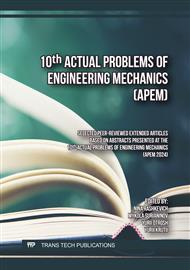[1]
H. Sulym, Ia. Pasternak, S. Kutsyk, Stress concentration and effective mechanical properties of plates with doubly periodic systems of enforced holes, J. Visnyk TNTU. 3 (67) (2012) 7-16.
Google Scholar
[2]
T. Galeta, P. Raos, J. Stojšić, I. Pakši, Influence of Structure on Mechanical Properties of 3D Printed Objects, J. Procedia Engineering. 149 (2016) 100-104.
DOI: 10.1016/j.proeng.2016.06.644
Google Scholar
[3]
K. Durgashyam, M. Indra Reddy, A. Balakrishna, K. Satyanarayana, Experimental investigation on mechanical properties of PETG material processed by fused deposition modeling method, J. Materials Today: Proceedings. 18 (6) (2019) 2052-2059.
DOI: 10.1016/j.matpr.2019.06.082
Google Scholar
[4]
A. Saxena, A. K. Srivastava, P. K. Kushwaha, S. Sharma, An investigation on the influence of three-dimensional printing orientation on the tensile and flexural strength of polymer and plastic materials, J. Mechanics of Advanced Materials and Structures IF. 2.8 (2024).
DOI: 10.1080/15376494.2024.2311853
Google Scholar
[5]
J. Loskot, D. Jezbera, R. Loskot, D. Bušovský, A. Barylski, K. Glowka, P. Duda, K. Aniołek, K. Voglová, M. Zubko, Influence of print speed on the microstructure, morphology, and mechanical properties of 3D-printed PETG products, J. Polymer Testing. 123 (2023).
DOI: 10.1016/j.polymertesting.2023.108055
Google Scholar
[6]
K. Szykiedans, W. Credo, D. Osiński, Selected Mechanical Properties of PETG 3-D Prints, J. Procedia Engineering. 177 (2017) 455-461.
DOI: 10.1016/j.proeng.2017.02.245
Google Scholar
[7]
S.H. Reza Sanei, Z. Lash, J. Servey, F. Gardone, C.P. Nikhare, Mechanical Properties of 3D Printed Fiber Reinforced Thermoplastic, ASME 2019 International Mechanical Engineering Congress and Exposition (2019).
DOI: 10.1115/imece2019-10303
Google Scholar
[8]
T. Fisher, J. Humberto S. Almeida Jr, B.G. Falzon and Z. Kazanci, Tension and Compression Properties of 3D-Printed Composites: Print Orientation and Strain Rate Effects, J. Polymers. 15(7) (2023)
DOI: 10.3390/polym15071708
Google Scholar
[9]
M. Batista, J. M. Lagomazzini, M. Ramirez-Peña and J. M. Vazquez-Martinez, Mechanical and Tribological Performance of Carbon Fiber-Reinforced PETG for FFF Applications, J. Appl. Sci. 13 (23) (2023).
DOI: 10.3390/app132312701
Google Scholar
[10]
J. Sedlak, Z. Joska, L. Hrbackova, E. Jurickova, D. Hrusecka, O. Horak, Determination of Mechanical Properties of Plastic Components Made by 3D Printing, J. Manufacturing Technology. 22 (6) (2022) 733-746.
DOI: 10.21062/mft.2022.082
Google Scholar
[11]
F.J.O. Ribeiro, M.F.O. de Miranda, N. dos S. Saad, A.Z. Guarato, Experimental analysis on the mechanical properties of petg parts made with fused deposition modeling manufacturing, Conference: 25th International Congress of Mechanical Engineering (2019).
DOI: 10.26678/abcm.cobem2019.cob2019-1931
Google Scholar
[12]
J. M. Mercado-Colmenero, M. D. La Rubia, E. Mata-Garcia, M. Rodriguez-Santiago and C. Martin-Doñate, Experimental and Numerical Analysis for the Mechanical Characterization of PETG Polymers Manufactured with FDM Technology under Pure Uniaxial Compression Stress States for Architectural Applications, J. Polymers (Basel). 12 (10) (2020).
DOI: 10.3390/polym12102202
Google Scholar
[13]
H. Sadaghian, B. Dadmand, M. Pourbaba, S. Jabbari and J. H. Yeon, The Effect of Size on the Mechanical Properties of 3D-Printed Polymers, J. Sustainability. 16 (1) (2024).
DOI: 10.3390/su16010356
Google Scholar
[14]
Information on https://3ddevice.com.ua/
Google Scholar
[15]
Information on https://en.wikipedia.org/wiki/Young%27s_modulus
Google Scholar
[16]
Information on https://www.sciencedirect.com/topics/physics-and-astronomy/proportional-limit
Google Scholar
[17]
Information on https://en.wikipedia.org/wiki/Yield_(engineering)
Google Scholar



